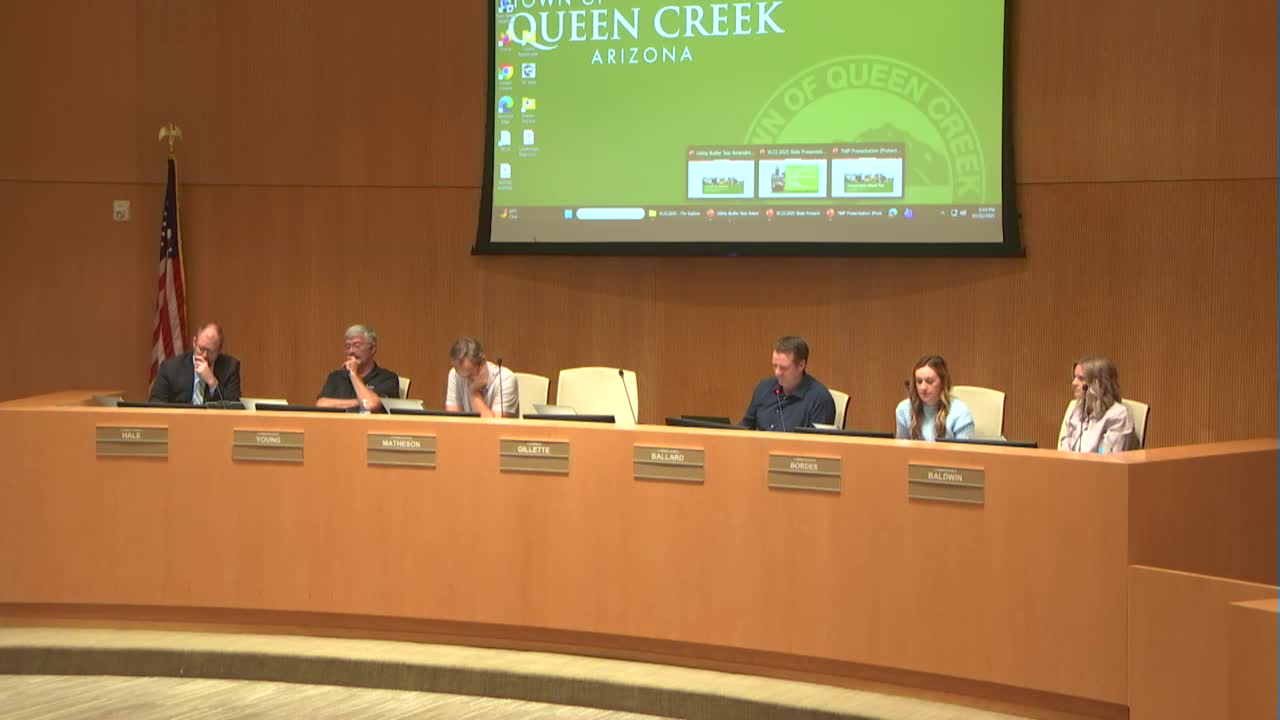Planning commission approves utility‑site buffer rules, disclosure requirements for new subdivisions
October 22, 2025 | Queen Creek, Maricopa County, Arizona
This article was created by AI summarizing key points discussed. AI makes mistakes, so for full details and context, please refer to the video of the full meeting. Please report any errors so we can fix them. Report an error »

Eric Swanson, planning manager for the Town of Queen Creek, presented a staff‑initiated text amendment that the commission approved requiring larger buffers and disclosure language for future utility well and pump sites that will be located near residential development.
Swanson said the town’s rapid growth has placed new residential construction closer to utility well sites and that wells can generate noise and vibration. To reduce future complaints, staff recommended standards for utility sites adjacent to planned residential development including an 8‑foot perimeter wall, a 50‑foot landscape buffer with plantings sufficient to assist with noise attenuation and the requirement that lots immediately abutting the buffer be limited to single‑story homes. Swanson said the 50‑foot width aligns with the town’s typical single‑family lot width and can be used as open‑space or retention area.
For utility sites adjacent to nonresidential development, Swanson said staff recommended a 20‑foot buffer (which could also serve as open space or retention). The proposal would also require disclosure statements in home‑purchase packets and mandatory language on future plats so buyers are warned if their lot is near a utility site.
Swanson showed examples where existing well sites sit adjacent to two‑story homes — notably Harvest Station at Signal Butte and Riggs — and said complaints there motivated the proposed changes. He said the amendment would not be retroactive and would apply only to future developments. He identified a few future locations where the standard could apply, including Box Canyon (southern end of town), a state land parcel and the PRI property at the northeast corner of Meridian and Germaine, where the town anticipates future well sites.
Swanson told commissioners that staff shared the draft amendment with the Home Builders Association of Central Arizona. He said the association opposed most of the recommended requirements except for the buyer disclosure language and plat note; the association’s concern was that mandatory buffers could reduce lot yields and affect development economics. Swanson said staff explained the amendment would not affect existing subdivisions or subdivisions already in the planning process.
The commission opened the public hearing; no one spoke. The commission voted to approve the text amendment (case p25‑0106). Chair David Gillette, Vice Chair Ballard, Commissioner Baldwin, Commissioner Bridal, Commissioner Hale, Commissioner Mathison and Commissioner Young voted aye; no no votes were recorded.
Swanson said staff will continue early negotiations with master developers about utility‑site locations and work with developers to implement the new standards for future plats and subdivisions.
Swanson said the town’s rapid growth has placed new residential construction closer to utility well sites and that wells can generate noise and vibration. To reduce future complaints, staff recommended standards for utility sites adjacent to planned residential development including an 8‑foot perimeter wall, a 50‑foot landscape buffer with plantings sufficient to assist with noise attenuation and the requirement that lots immediately abutting the buffer be limited to single‑story homes. Swanson said the 50‑foot width aligns with the town’s typical single‑family lot width and can be used as open‑space or retention area.
For utility sites adjacent to nonresidential development, Swanson said staff recommended a 20‑foot buffer (which could also serve as open space or retention). The proposal would also require disclosure statements in home‑purchase packets and mandatory language on future plats so buyers are warned if their lot is near a utility site.
Swanson showed examples where existing well sites sit adjacent to two‑story homes — notably Harvest Station at Signal Butte and Riggs — and said complaints there motivated the proposed changes. He said the amendment would not be retroactive and would apply only to future developments. He identified a few future locations where the standard could apply, including Box Canyon (southern end of town), a state land parcel and the PRI property at the northeast corner of Meridian and Germaine, where the town anticipates future well sites.
Swanson told commissioners that staff shared the draft amendment with the Home Builders Association of Central Arizona. He said the association opposed most of the recommended requirements except for the buyer disclosure language and plat note; the association’s concern was that mandatory buffers could reduce lot yields and affect development economics. Swanson said staff explained the amendment would not affect existing subdivisions or subdivisions already in the planning process.
The commission opened the public hearing; no one spoke. The commission voted to approve the text amendment (case p25‑0106). Chair David Gillette, Vice Chair Ballard, Commissioner Baldwin, Commissioner Bridal, Commissioner Hale, Commissioner Mathison and Commissioner Young voted aye; no no votes were recorded.
Swanson said staff will continue early negotiations with master developers about utility‑site locations and work with developers to implement the new standards for future plats and subdivisions.
View full meeting
This article is based on a recent meeting—watch the full video and explore the complete transcript for deeper insights into the discussion.
View full meeting
